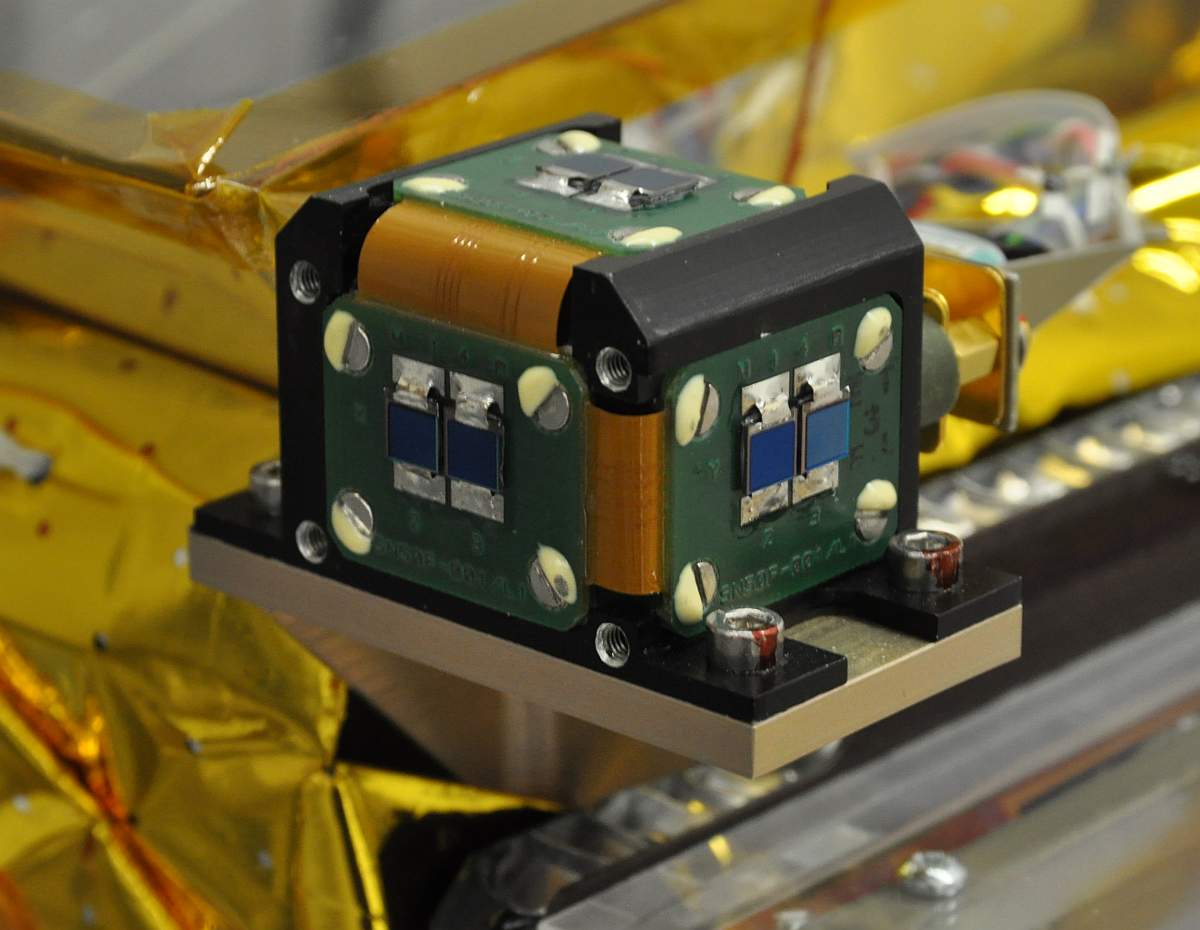|
SI Imaging Services
Satrec Initiative Co., Ltd. (Satrec I; ) or SI is a South Korean satellite manufacturing company headquartered in Daejeon, South Korea The company was founded in 1999 by the engineers who developed the first Korean satellite (KITSAT-1) at KAIST SaTRec ( Satellite Technology Research Center). The company designs and builds Earth observation satellites called SpaceEye-series, and it provides various space components, including high resolution electro-optical payloads and star-trackers. SI's first satellite was a Malaysian Earth observation satellite, RazakSAT launched in 2009. SI has two subsidiaries: SI Imaging Services (SIIS) is the exclusive image data provider of KOMPSAT-series, and SI Analytics (SIA) provides AI-native GEOINT solutions for satellite imagery. SI also spun-off SI Detection (SID), which provides radiation monitoring solutions. History Satrec Initiative was founded in Daejeon, South Korea in 1999. There are two subsidiaries established based on SI's business i ... [...More Info...] [...Related Items...] OR: [Wikipedia] [Google] [Baidu] |
Public Company
A public company is a company whose ownership is organized via shares of share capital, stock which are intended to be freely traded on a stock exchange or in over-the-counter (finance), over-the-counter markets. A public (publicly traded) company can be listed on a stock exchange (listing (finance), listed company), which facilitates the trade of shares, or not (unlisted public company). In some jurisdictions, public companies over a certain size must be listed on an exchange. In most cases, public companies are ''private'' enterprises in the ''private'' sector, and "public" emphasizes their reporting and trading on the public markets. Public companies are formed within the legal systems of particular states and so have associations and formal designations, which are distinct and separate in the polity in which they reside. In the United States, for example, a public company is usually a type of corporation, though a corporation need not be a public company. In the United Kin ... [...More Info...] [...Related Items...] OR: [Wikipedia] [Google] [Baidu] |
KAIST Satellite Technology Research Center
KAIST Satellite Technology Research Center (SaTReC; ), is a university based research center for satellite technology and applications research. Space Programme SaTReC, which is located within the Korea Advanced Institute of Science and Technology (KAIST), promotes the education and training of satellite engineers through research programs in satellite engineering, space science and remote sensing. In 1992, SaTReC developed and launched the first satellite of Korea, KITSAT-1, a scientific microsatellite. Since then, SaTReC continues to develop satellites with scientific and technology demonstration missions. Satellite Missions * Development and Operations of Kitsat-1 * Development and Operations of Kitsat-2 KITSAT-2 (Pseudonym, a.k.a. ''"Uribyol 2", "KITSAT-OSCAR 25", "KO-25" and "KITSAT-B"'') was a South Korean experimental Earth observation satellite, Earth observation Small satellite, microsatellite. KITSAT-2 was South Korea's second satellite ... * Development and Oper ... [...More Info...] [...Related Items...] OR: [Wikipedia] [Google] [Baidu] |
X-Sat
X-Sat is a microsatellite developed and built by the Nanyang Technological University (NTU) in collaboration with Defence Science Organisation (DSO) Singapore. The satellite was launched by ISRO's PSLV-C16 on 20 April 2011 from Satish Dhawan Space Centre FLP in Sriharikota, India. The satellite was launched along with Indian ResourceSat-2 and Indo-Russian YouthSat YouthSat is a Russian-Indian scientific-educational Satellite, artificial satellite developed on the basis of an agreement between the Russian Federal Space Agency and the Indian Space Research Organisation, Indian Space Research Organisation (ISRO .... Project Objectives * Create an affordable microsatellite bus that can conduct remote sensing operations in situations close to real-time. * To increase the nation's capacity (resources and infrastructure) for satellite engineering * To encourage academic interest in this field's R&D References External links NSSDC ID: 2011-015C [...More Info...] [...Related Items...] OR: [Wikipedia] [Google] [Baidu] |
Spacecraft Attitude Control
Spacecraft attitude control is the process of controlling the orientation of a spacecraft (vehicle or satellite) with respect to an inertial frame of reference or another entity such as the celestial sphere, certain fields, and nearby objects, etc. Controlling vehicle attitude requires actuators to apply the torques needed to orient the vehicle to a desired attitude, and algorithms to command the actuators based on the current attitude and specification of a desired attitude. Before and during attitude control can be performed, spacecraft attitude determination must be performed, which requires sensors for absolute or relative measurement. The broader integrated field that studies the combination of sensors, actuators and algorithms is called ''guidance, navigation and control'', which also involves non-attitude concepts, such as position determination and navigation. Motivation A spacecraft's attitude must typically be stabilized and controlled for a variety of reasons. It ... [...More Info...] [...Related Items...] OR: [Wikipedia] [Google] [Baidu] |
Electro-optics
Electro–optics is a branch of electrical engineering, electronic engineering, materials science, and material physics involving components, electronic devices such as lasers, laser diodes, LEDs, waveguides, etc. which operate by the propagation and interaction of light with various tailored materials. It is closely related to photonics, the branch of optics that involves the application of the generation of photons. It is not only concerned with the " electro–optic effect", since it deals with the interaction between the electromagnetic ( optical) and the electrical ( electronic) states of materials. Electro-optical devices The electro-optic effect is a change in the optical properties of an optically active material in response to changes in an electric field. This interaction usually results in a change in the birefringence Birefringence, also called double refraction, is the optical property of a material having a refractive index that depends on the polari ... [...More Info...] [...Related Items...] OR: [Wikipedia] [Google] [Baidu] |
RASAT
RASAT was an Earth observation satellite designed and developed by TÜBİTAK Space Technologies Research Institute (TÜBİTAK UZAY) and produced in Turkey to provide high resolution imagery. It was the first remote sensing satellite fully realized in Turkey, and the second indigenously developed remote sensing satellite after BILSAT-1. Financed by the State Planning Organization (DPT) and designed by TÜBİTAK UZAY without any international know-how transfer, RASAT was launched from Dombarovskiy Cosmodrome, near Yasny in Russia by a Dnepr space launch vehicle at 08:12:20 UTC on August 17, 2011, along with seven other satellites Sich-2 and BPA-2 of Ukraine, NigeriaSat-2 and NigeriaSat-X of Nigeria, EduSat of India as well as AprizeSat-5 and AprizeSat-6 of Italy. RASAT was placed 16 minutes and 9 seconds after the lift-off into a low Earth orbit of . The first signal from RASAT was received in the space center of Andøya Rocket Range, northern Norway at 09:44:04 UTC. RA ... [...More Info...] [...Related Items...] OR: [Wikipedia] [Google] [Baidu] |
Mission Control Center
A mission control center (MCC, sometimes called a flight control center or operations center) is a facility that manages spaceflight, space flights, usually from the point of launch until landing or the end of the mission. It is part of the ground segment of spacecraft operations. A staff of flight controllers and other support personnel monitor all aspects of the mission using telemetry, and send commands to the vehicle using ground stations. Personnel supporting the mission from an MCC can include representatives of the attitude control system, electric power, power, spacecraft propulsion, propulsion, thermal, attitude dynamics and control, attitude dynamics, orbital operations and other subsystem disciplines. The training for these missions usually falls under the responsibility of the flight controllers, typically including extensive rehearsals in the MCC. Government-operated Mission Control Centers ;America * Launch Control Center, NASA Launch Control Center controls NASA ... [...More Info...] [...Related Items...] OR: [Wikipedia] [Google] [Baidu] |
Sun Sensor
A Sun sensor is a navigational instrument used by spacecraft to detect the position of the Sun. Sun sensors are used for Spacecraft attitude control, attitude control, solar array pointing, gyroscope, gyro updating, and safe mode (spacecraft), fail-safe recovery. In addition to spacecraft, Sun sensors find use in ground-based weather stations and Sun-tracking systems, and aerial vehicles including Balloon (aeronautics), balloons and Unmanned aerial vehicle, UAVs. Mechanism There are various types of Sun sensors, which differ in their technology and performance characteristics. Sun presence sensors provide a binary number, binary output, indicating when the Sun is within the sensor's field of view. Analog electronics, Analog and digital electronics, digital Sun sensors, in contrast, indicate the angle of the Sun by continuous and discrete signal outputs, respectively. In typical Sun sensors, a thin slit at the top of a rectangular chamber allows a line of light to fall on an array ... [...More Info...] [...Related Items...] OR: [Wikipedia] [Google] [Baidu] |
COMS-1
Chollian, () also known as Communication, Ocean and Meteorological Satellite 1 (COMS-1), was a South Korean satellite which was launched on 26 June 2010 and began operations on 1 April 2011. It was operated by the Korea Aerospace Research Institute, who used it for communication, oceanography, and meteorological observation. COMS-1 was constructed by EADS Astrium, and was based on the Eurostar-3000S satellite bus, bringing together lessons learned from Eurostar satellites and NASA-made GOES satellites respectively. It had a mass of , and carried transponders broadcasting in the D/ E and K bands of the NATO-defined spectrum, or the L/ S and Ka bands of the IEEE-defined spectrum respectively. Its single solar array generated a minimum of 2.5 kilowatts of power. COMS-1 was launched by Arianespace using an Ariane 5 ECA carrier rocket lifting off from ELA-3 at the Guiana Space Centre in Kourou, French Guiana. The first launch attempt occurred on 23 June 2010; the launch was scrub ... [...More Info...] [...Related Items...] OR: [Wikipedia] [Google] [Baidu] |
DubaiSat-1
DubaiSat-1 () is a remote sensing Earth observation satellite built by the ''Mohammed bin Rashid Space Centre (MBRSC)'' under an agreement with Satrec Initiative, a satellite manufacturing company in South Korea. DubaiSat-1 was launched on 29 July 2009 into a 680 km altitude Sun-synchronous polar orbit from the Baikonur launch site in Kazakhstan, along with several other satellites on board the Dnepr launch vehicle. Overview DubaiSat-1 observes the earth at a Low Earth orbit (LEO) and generates high-resolution optical images at 2.5 m in panchromatic (black-and-white) and at 5 m in multispectral (colour) bands. These images provide decision makers in the UAE as well as MBRSC clients with a valuable tool for a wide range of applications including infrastructure Infrastructure is the set of facilities and systems that serve a country, city, or other area, and encompasses the services and facilities necessary for its economy, households and firms to function. Infra ... [...More Info...] [...Related Items...] OR: [Wikipedia] [Google] [Baidu] |
KOMPSAT-2
KOMPSAT-2 (Korean Multi-purpose Satellite-2), also known as Arirang-2, is a South Korean multipurpose Earth observation satellite. It was launched from Plesetsk Cosmodrome, Russia at 07:45:43 Coordinated Universal Time, UTC (16:05:43 Korea Standard Time, KST) on 28 July 2006. It began to transmit signals at 14:00 UTC (23:00 KST) the same day. Like the earlier KOMPSAT-1 satellite, it takes its name from the popular Korean folk song Arirang. Its launch was the culmination of a project begun in 1995. KOMPSAT-2 orbits at a height of , circling the Earth 14 times per day, and is expected to maintain that orbit for 3 years. It weighs . The satellite carries a Multispectral Camera (MSC) which can distinguish to a 100-cm resolution, allowing the identification of individual vehicles on the ground. The satellite was succeeded by KOMPSAT-3, KOMPSAT-5 and KOMPSAT-3A, which were launched in 2012, 2013 and 2015 respectively. History South Korea started the KOMPSAT programme in 1995 to nur ... [...More Info...] [...Related Items...] OR: [Wikipedia] [Google] [Baidu] |


